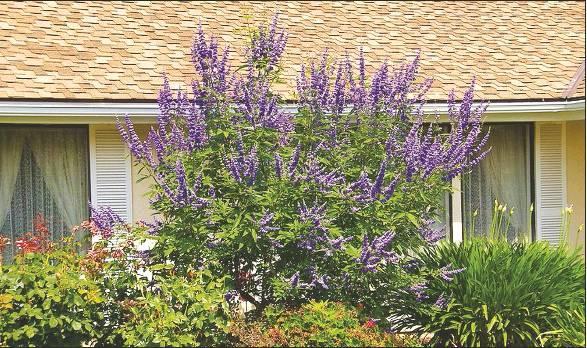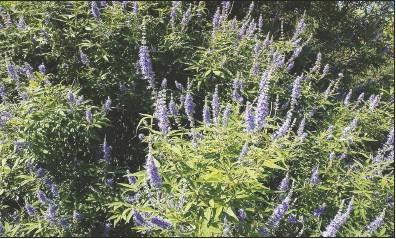My Neighbor’s Beautiful Tree
Like most of us, I am a creature of habit. When I drive out of my neighborhood, I tend to go down the same streets, following the same directions, and making the same turns every single time. Yesterday, however, road construction on my street forced me to change my routine and I am very glad it did! Driving the opposite direction from my usual, I got the chance to notice some of the landscapes in my locality that I had not seen in some time.
Just about a dozen houses from my own I came across a well-kept yard with a beautiful flowering tree in the center of the front yard. It was covered with lovely bluish-purple flowers that were in perfect bloom, surrounded by a rich green of the canopy, the sight was absolutely stunning. What was that amazing tree? Nope, not a crepe myrtle, though I love crepe myrtles, this was something else, a Shoal Creek Chaste Tree. You may know it better as vitex, monk’s pepper, or as a chasteberry tree. If you want a tough, yet gorgeous, shrub or small tree that is a butterfly, bee, and hummingbird magnet, then this is a must for your garden.
The Vitex (Vitex agnus-castus) is a native of China and India, although long ago (many thousands of years ago) it became naturalized throughout most of the southern United States. It also has a long history as a medicinal plant. The English name “chaste tree” and the common name “monk’s pepper” refer to beliefs that parts of the plant reduce libidinal desires. Early-American physicians used it to stimulate lactation and as an emmenagogic. Native to southern Europe and central Asia, the chaste tree quickly grows into a multi-trunked tree. As mentioned above, it gets its name from the erroneous medieval belief that a potion made from it could curb the libido. In reality, wearing a 1980’s shoulder-padded blazer with orthopedic shoes and multiple nose piercings would be much, much more effective.
Herbalists agree that Vitex neither represses sexual passion, as the ancient Greeks who gave it the name Agnus casus (chaste), believed, nor does it act as a true aphrodisiac as other cultures have claimed. That doesn’t mean that chaste tree doesn’t have its pharmacological uses. The Vitex, according to Green Pharmacy Herbal Handbook (2000) is a normalizing herb for the female reproductive system, a regulator of the hormonal balance of estrogen and progesterone. And according to Rosemary Gladstar in her 1993 book, Herbal Healing for Women, this normalizing of hormones is what makes the herb valuable in treating painful and irregular menses, PMS, menopause and infertility. For chronic problems, she advises, it is most effective when taken over a prolonged period of time. It is also known that Vitex berry tinctures were traditionally prescribed for pain and weakness in the limbs. Remember to consult your doctor or healthcare professional before starting this or any herbal therapy.
In the gardening world of central Texas, the Shoal Creek Chaste Tree is known as a spectacular, butterfly and bee attracting plant. The 12-inch, fragrant flower spikes of deep lavender blue provide a wonderful addition to summer landscape color without the work involved with bedding plants. The flowers appear in May/June with a second flush of flowers in August. This versatile plant can be trained as a large shrub or small multi-trunked tree about 10 to 15 feet tall and wide. Shoal Creek vitex is more vigorous and produces larger flowers and deeper color than its other vitex cousins.
Once established, vitex is very drought tolerant and fits in well to a lower-maintenance landscape. It prospers in hot and dry environments. It is deer-resistant in that deer will not usually eat it – take that for what it is worth because I believe a deer will eat a brick if it is hungry enough.
The Shoal Creek vitex with its blue-violet flowers is my favorite, but it has a few crowd-pleasing cousins you might find interesting too. Of course, the best thing about these trees, in my humble opinion, are the flowers. The chaste tree is one of the very few winter-hardy trees out there that sports long lasting summer flowers - although they can also be pink, purple, or white I am partial to the bluish purple. The variety ‘Abbeville Blue’ offers the truest blue hue and bears large, spectacular panicles of deep-blue flowers all summer. Others of interest are the ‘Montrose Purple’ with, you guessed it, purple blooms, and the ‘Silver Spires’ variety which sports bright white flowers. If you buy an unnamed chaste tree from a nursery, be sure to buy it in bloom so you can see the color of the flowers and the general shape of the plant.
Adding fresh, long-lasting color in the summer landscape, the Shoal Creek Chaste Tree and its vitex cousins are deciduous, vaseshaped shrubs noted for their long blooming season and disease-resistant foliage. Growing with dense, upright habits, they feature sage-scented, grayish-green palmate (hand-shaped) leaves with five to seven leaflets and silvery undersides that flicker in the wind and produce a lovely effect. These trees are highly ornamental with spectacular sprays often 12 inches long, of small, fragrant, vibrant flowers that appear from summer to fall, attracting scores of butterflies, hummingbirds and bees.
Exceptionally vigorous, the Shoal Creek Vitex grows, with a spreading habit, up to 4-15 feet tall and 4-12 feet wide. This versatile plant can be trained as a large shrub or small multi-trunked tree much like the crape myrtle. In cold winter areas, the Chaste Tree grows only as a modest-sized perennial shrub because it often suffers winter dieback or dies to the ground – not a problem for us in zones 8a and 8b. Even though plants may die to the ground in Zone 5-7 winters, the roots survive and push up as much as 4-7 foot of new growth the following year showing just how tough it really is.
One of my favorite things about this shrub/tree is that it develops a naturally well-balanced shape and doesn’t require much pruning. Its ease of growth, low maintenance, drought hardiness, summer color, deer resistance, and medicinal characteristics makes this lovely tree a wonderful addition to any landscape without the work involved with bedding plants! Why don’t we all have this in our yard?
So, whether you want to stimulate the presence of butterflies in your backyard with a drought-tolerant, pest-resistant plant, or whether you want to try some ancient herbal remedies, this Texas Superstar will make a statement in your garden. Texas Superstar® plants are tested and selected for their superstar performance in the Texas landscape. For more information on Texas Superstar plants point your favorite browser to: www.texassuperstar.com.




